
When snow blankets your driveway, you might wonder if it’s safe to clear your pavers with a snow plow. The answer isn’t a simple yes or no; it hinges on the method and tools you use. Mechanical methods like plowing, shoveling, or snow blowing can be paver-friendly when done right.
Using the correct equipment is key to protecting your pavers during snow removal. Opt for plastic shovels and snow blowers with non-metallic shoes to avoid scratches. Chemical de-icers also play a role, but choosing the right type is crucial to prevent damage from freeze-thaw cycles.
Can You Snow Plow Pavers
When winter weather hits, you’ll need to clear your driveway or walkway. But if they’re made of pavers, you might wonder about the best method to remove snow without causing damage. The short answer is yes, you can use a snow plow on pavers, but it requires the right approach to ensure your surfaces stay pristine.
Mechanical Methods that protect your pavers include:
- Using Plastic Shovels: Unlike metal, plastic is less likely to scrape or scratch the surface of your pavers.
- Selecting Snow Plows with Rubber or Polyurethane Cutting Edges: These materials are softer than steel and are designed to glide over the paver surface without inflicting scratches.
- Choosing Snow Blowers with Polyurethane or Plastic Shoes: Much like the right plow blade, these non-metallic shoes lessen the risk of scuffing your pavers as you clear snow.
Remember to avoid tire chains on snow blowers and vehicles equipped with a plow. Even though their usefulness in gaining traction, the hard steel can leave unsightly marks on your pavers.
In terms of Chemical Methods, it’s wise to proceed with caution. Techo-Bloc, a paver manufacturer, states that rock salt is safe for some of their products. But, this isn’t a universal endorsement, and many manufacturers advise against it due to potential freeze-thaw damage.
- Avoid magnesium-based products as recommended by Unilock.
- Use ice melters sparingly to prevent them from seeping into the pavers and triggering freeze-thaw cycles. Regular maintenance using these guidelines will help ensure your pavers remain in excellent condition, even through the harsh demands of winter.
Understanding Pavers and Snow Plowing
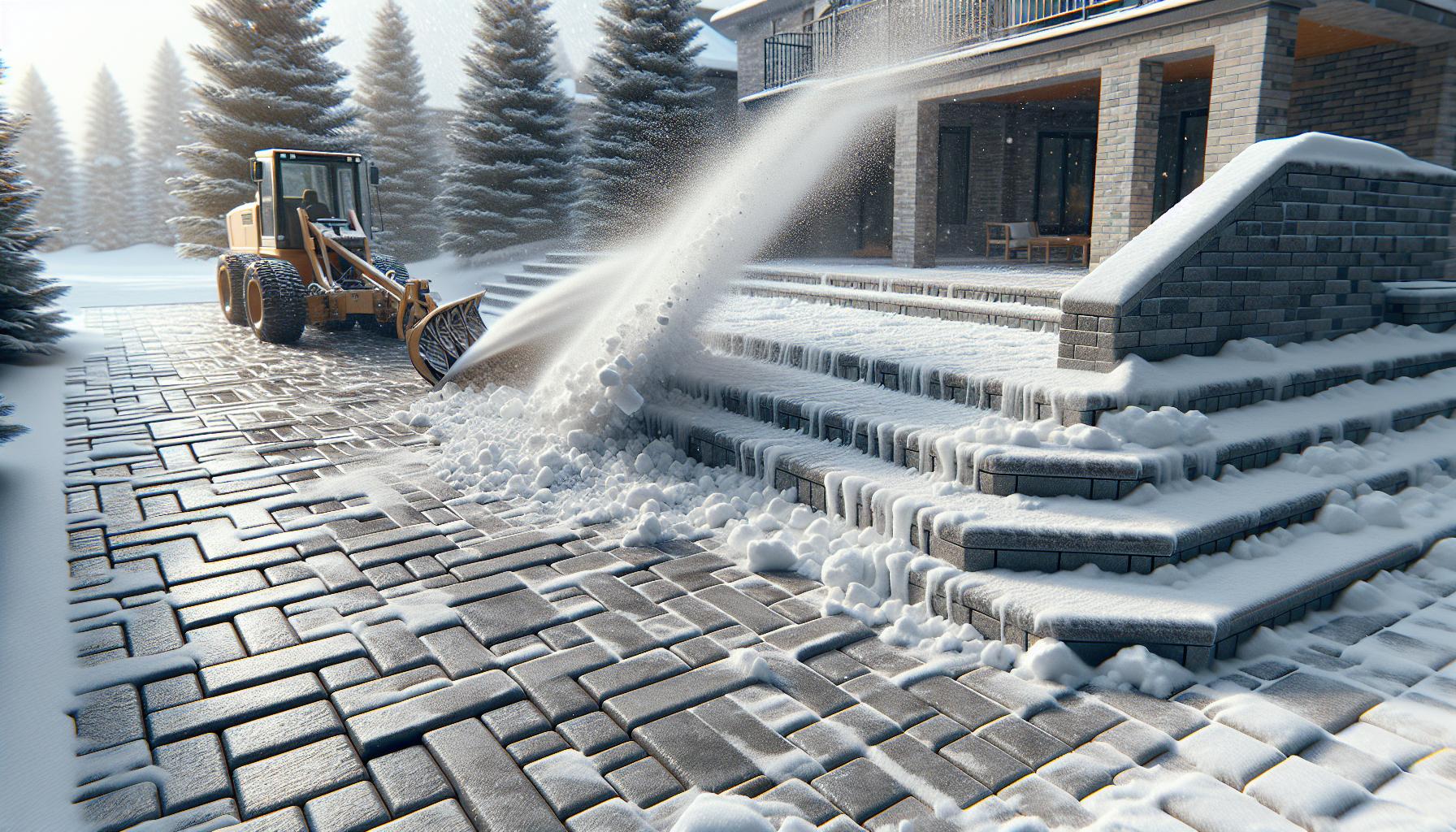
What Are Pavers
Pavers refer to the interlocking blocks made from various materials like concrete, clay, or high-density polyethylene (HDPE) used to create flat surfaces for driveways, patios, walkways, and other outdoor areas. Their installation involves placing them on a supportive sub-base which is often comprised of crushed rock or concrete and then filling the joints between the blocks with sand or other fine materials.
The main attributes of pavers are:
- Durability: They are designed to withstand heavy usage and diverse weather conditions.
- Permeability: Many paver systems allow water to drain through, reducing the risk of pooling and ice formation.
- Aesthetics: Pavers come in a variety of shapes, colours, and textures to complement any world design.
With these qualities in mind, it’s critical to maintain the integrity of your pavers, particularly during inclement weather such as heavy snowfall.
Importance of Snow Plowing
Snow plowing is an essential practice for ensuring safe and accessible pavements during the winter months. Without it, snow can build up, making surfaces slippery and obstructing traffic or pedestrian movement. Especially for businesses and public areas, this poses a liability risk.
Efficient snow plowing on pavers encourages:
- Safety: It reduces the potential for accidents by providing clear, navigable paths.
- Longevity of Pavers: Correctly executed snow plowing protects pavers from scratches and other damage, maintaining their appearance and structural integrity.
- Reduced Ice Formation: By removing snow before it compacts into ice, plowing helps to prevent the freeze-thaw cycle that can harm the pavers and cause spalling.
As you consider snow plowing options for your paved areas, it’s paramount that the chosen methods align with the specific type of pavers and their unique characteristics.
Factors to Consider Before Snow Plowing Pavers
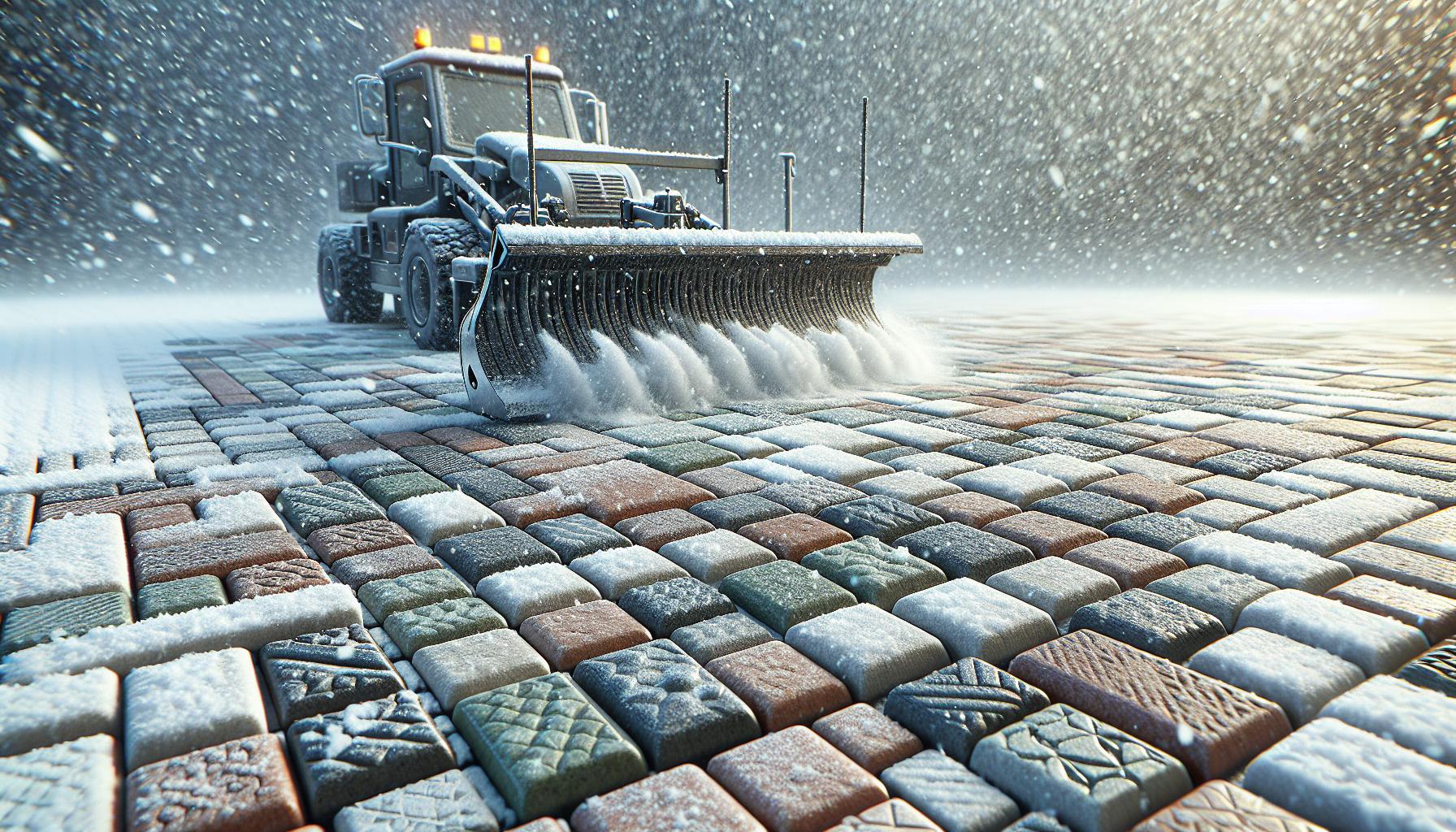
When the snow begins to fall, it’s crucial to prepare for safe and efficient snow removal. If you’ve installed pavers on your property, careful consideration before plowing is vital to maintain their integrity. Here are important factors to evaluate before you clear the snow from your pavers.
Type of Pavers
The type of pavers you have in place greatly influences the snow plowing approach you’ll take. Remember:
- Concrete Pavers: Typically dense and difficult to scratch, but require careful handling to prevent chipping edges.
- Clay Pavers: Often durable, yet common red brick varieties may be softer and more susceptible to damage.
- Permeable Pavers: Allow water to drain efficiently, reducing the risk of ice but may need a gentle touch to avoid dislodging the gravel in-fill.
Pro Tip: Always check the manufacturer’s recommendations for snow removal on your specific pavers.
Condition of Pavers
Before the winter season hits, assess the current condition of your paver installation.
- Look for any signs of pre-existing damage like cracks or loose units which could be exacerbated by plowing.
- Ensure paver joints are properly filled to prevent shifting or lifting during snow removal.
Effective Maintenance: Regular inspections and timely repairs during the year ensure your pavers are in the best condition to withstand the rigours of snow plowing.
Climate and Weather Conditions
Your local climate and expected weather conditions play a significant role in how you approach snow plowing on pavers.
- Heavy Snowfall Areas: Consider the potential for deep snow which necessitates frequent plowing. Opt for equipment that’s gentle on pavers.
- Temperate Regions: Less frequent snow may allow for softer removal methods like shovelling.
- Freeze-Thaw Cycles: These can cause pavers to heave or crack, so choose a snow removal method that minimises water retention on the surface.
Strategic Planning: Knowing the weather patterns enables you to select appropriate snow removal timings and techniques, reducing potential damage to your pavers.
Snow Plowing Techniques for Pavers
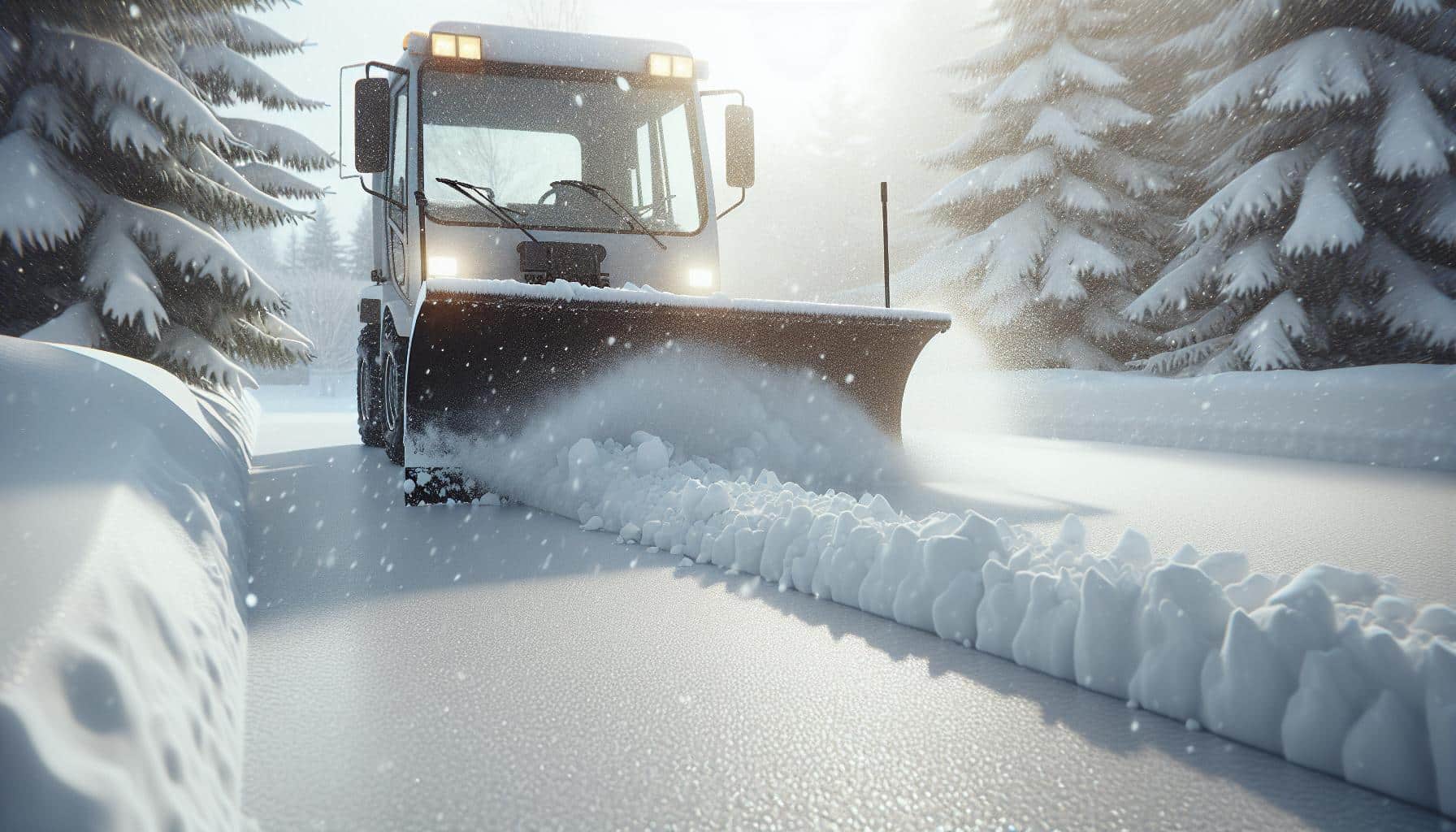
When heavy snow blankets your pavers, a careful approach to removal will maintain their integrity and aesthetics. Here’s how you can efficiently clear your pavements without causing damage.
Using a Snow Plow with Rubber Blade Attachments
Choosing the right snow plow equipment is paramount to protect your paver installations. For larger areas, the use of snow plows with rubber blade attachments is recommended due to their gentle touch on hard surfaces.
- The rubber blades minimize direct contact between the metal plow and the pavers.
- Reduces the risk of scuffing or scratching the paver’s surface.
- Essential for maintaining the pristine condition of your pavers during the snow clearing process.
Also, when rubber blades are not usable or available, another acceptable method involves setting the plow’s blade 1 to 2 inches above the paver system. This ensures there is no direct contact that could lead to chipping or catching on the pavers.
Manual Snow Shoveling
For smaller residential areas or when dealing with porous pavement, manual shoveling is often the best solution. A plastic snow shovel should be your tool of choice as it provides a few essential benefits:
- Plastic shovels are kinder to the paver’s surface than metal options.
- Greater control over the force used, reducing the potential for damage.
- Low cost and ease of use make them ideal for prompt, gentle snow removal.
But, when manually shoveling, always remember to use techniques that avoid dragging the shovel’s edge across the pavers to prevent unwanted abrasion.
Snow Melting Techniques
In certain circumstances, snow melting techniques can be a complement to physical methods, particularly for permeable pavers. These methods use the property of permeable materials which allows the warmth from the ground to rise and melt snow without the need for deicers. But, if you choose to use deicing products, here are some guidelines:
- Verify that the deicer is safe for use on your specific type of pavers as recommended by the manufacturer.
- Apply the deicer sparingly to the remaining snow layer to minimize environmental impact.
- Avoid salt-based deicers that can penetrate and degrade the pavers or the surrounding vegetation.
It’s crucial to acknowledge that the effectiveness of deicers largely depends on the type of pavers and the local climate, as well as the specific product you choose to use.
Precautions to Take While Snow Plowing Pavers
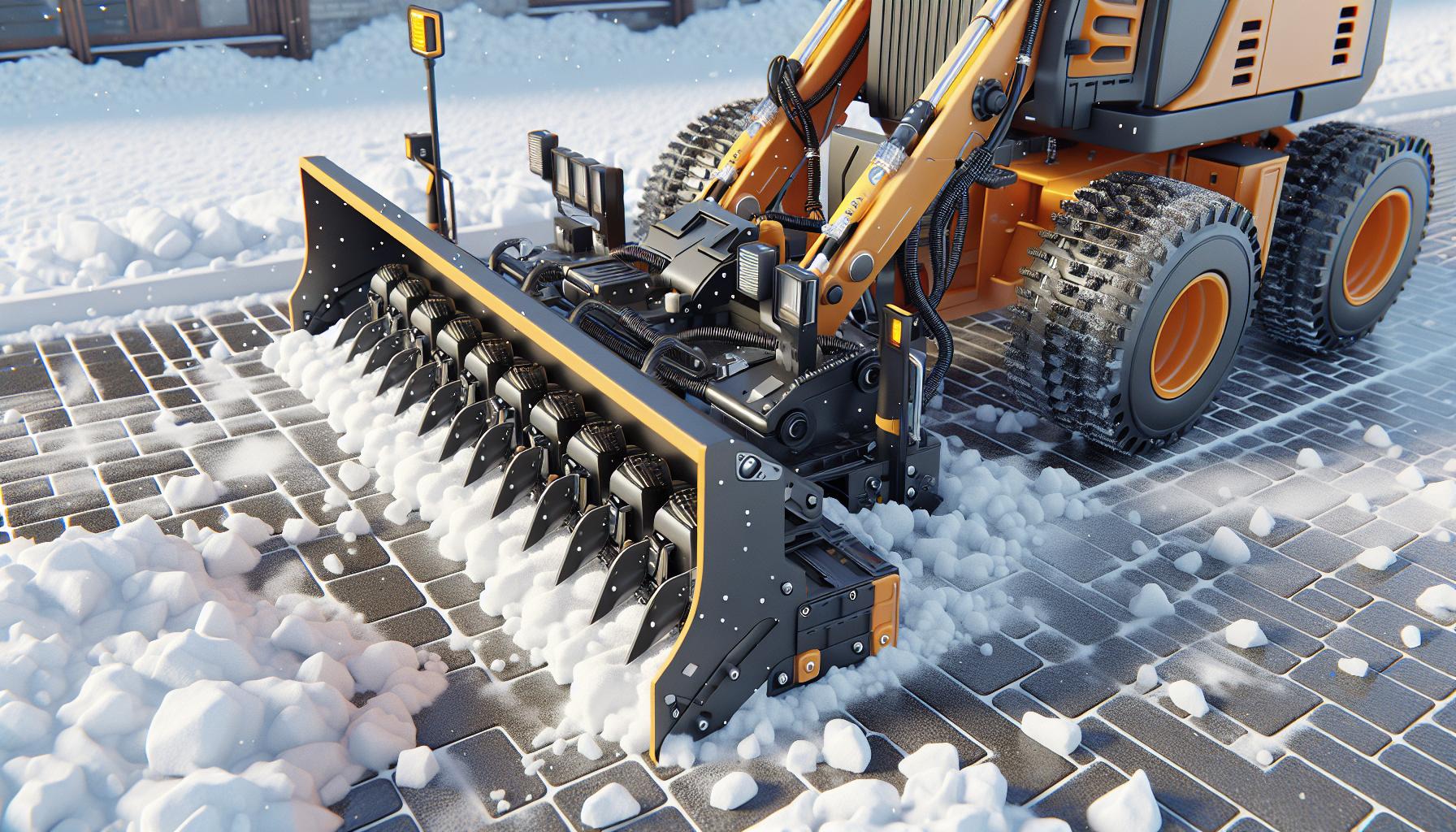
When facing the task of clearing snow from your paver-covered surfaces, it’s crucial to adopt certain precautions. These measures will help maintain the integrity of your pavers whilst ensuring efficient snow removal.
Avoid Using Metal Blades
The use of metal blades on your snow removal equipment can be detrimental to the surface quality of your pavers:
- Metal Blades Can Scratch Pavers: They pose a risk of scratching or scuffing the surface, leading to permanent, unwanted marks.
- Risk of Rust Stains: Small metal fragments left behind may lead to rust stains, compromising the aesthetic appeal of your pavement. Best Practice: Opt for a snow removal tool with a plastic shovel or ensure that your snow plow or blower is fitted with a plastic blade protector. Such a precaution not only preserves the look of your pavers but also contributes to their longevity.
Adjusting Plow Height
When plowing paver surfaces, protect the integrity of your pavement by:
- Setting Plow Height: Adjust the snow plow blade to remain 1 to 2 inches above the paver system to prevent damage to the units.
- Preventing System Catch: This height adjustment also aids in avoiding the plow blade from catching on the edges of the pavers, which could dislodge or shift them.
Blade Shoes: In areas filled with gravel or on porous pavers, consider using snow blade shoes to shield the pavers from excess wear while keeping the blades at an optimal level above the pavers.
Using Adequate Amounts of Deicers
Responsible use of deicers is essential to protect your paver installation and the environment:
- Environmental Concerns: Choose deicers safe for both the type of pavers and the surrounding flora and fauna.
- Rock Salt: Sodium Chloride, also known as rock salt, is effective down to 16°F (-9°C) and should be used sparingly to minimize damage to adjacent grass and metal structures.
Snow Melting Systems: Although deicers can help, for those with significant ice problems, installing a snow melt system beneath the pavers could be a valuable, long-term investment. It helps reduce the need for chemicals and manual snow removal efforts.
When dealing with snow on your pavers, you’re tasked with balancing efficiency and care. Make smart choices about your equipment and deicing materials. Ensure that any contractors you hire for snow removal are well-reviewed and that their equipment is suitable for use on pavers, such as possessing Teflon blades, to prevent scratches and other damage. By taking these precautions, you can keep your paved surfaces safe throughout the winter months while effectively managing snowfall.
Benefits of Snow Plowing Pavers
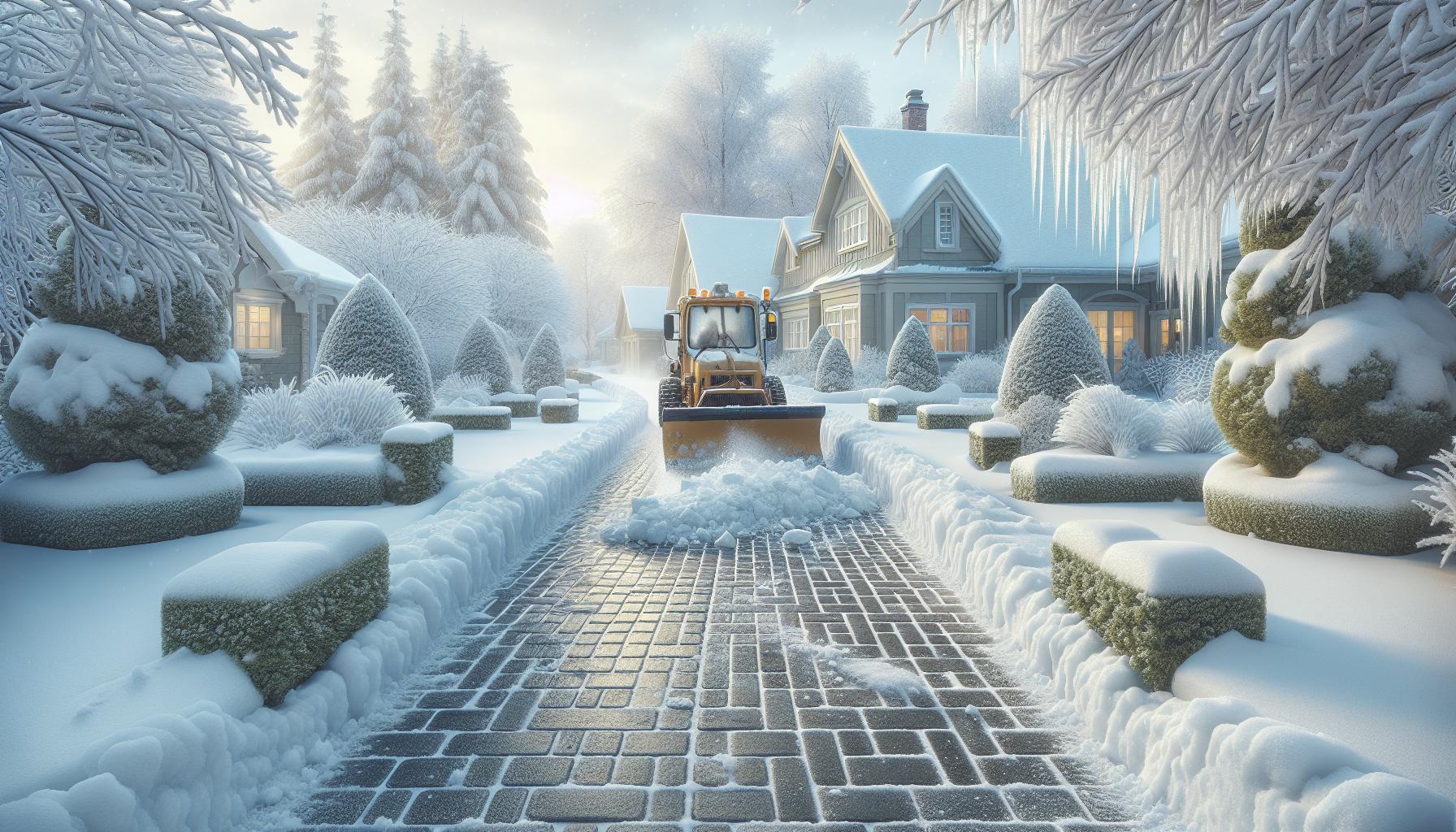
Proper snow removal from paver driveways and walkways is crucial, not only for the functionality of these surfaces but also for their longevity and appearance. Let’s investigate into why plowing your pavers is beneficial and how it can contribute positively to your property’s upkeep.
Preventing Damage to Pavers
Regular snow plowing aids in avoiding the freeze-thaw cycle’s harmful effects on your pavers. When water seeps into the joints and then freezes, it can cause pavers to heave or shift, potentially leading to costly repairs. Here’s why diligent snow removal is important:
- Reduces water infiltration: By keeping pavers clear, you minimize water seeping between them, decreasing the risk of ice formation and expansion of joints.
- Preserves structural integrity: Pavers are designed for durability, but regular maintenance, including snow plowing, is essential to prevent shifting and cracking. By promptly removing snow, you’re ensuring that water doesn’t freeze and expand within the pavers, preventing damage and maintaining the stability of your paved area.
Maintaining Aesthetics of Pavers
The visual appeal of your pavers plays a significant role in your property’s overall aesthetics. Here are the advantages of keeping them clear of snow and ice:
- Prevents staining: Chemical deicers can leave behind stains. By plowing the snow, you reduce the need for chemicals, keeping pavers pristine.
- Retains original appearance: Accumulation of snow and ice can mask the beauty of your pavers. Clear surfaces showcase their design and colour.
A well-maintained paver surface sans snow and leftovers from deicing processes ensures that your paved areas remain visually appealing year-round.
Enhancing Safety on Paved Surfaces
Safety is paramount, and it’s no different when it comes to paver surfaces. Here’s how plowing snow off your pavers enhances safety:
- Eliminates slip hazards: A clear surface prevents the formation of ice patches, reducing the risk of slips and falls.
- Improves visibility: With the snow removed, any changes in elevation or potential hazards on the pavers are more visible, so avoiding accidents.
Snow plowing ensures a safe, walkable, and drivable surface, preventing potential injuries and liabilities associated with icy and snow-covered pavements.
Conclusion
You now understand the importance of snow plowing your pavers. Not only does it protect them from the ravages of winter’s freeze-thaw cycles but it also maintains their beauty and structural integrity. By keeping your paved surfaces clear you’re ensuring safety and preserving the value of your investment. Remember regular maintenance is key to the longevity of your pavers so don’t hesitate to keep them snow-free. Your pavers will thank you for it with years of good looks and steadfast service.
Colin Macmillan is a seasoned entrepreneur and the CEO of Riverwood Landscape, a leading landscaping company based in Canada. He has been at the helm of the company since leaving high school, demonstrating his strong leadership skills and business acumen.
Colin’s expertise lies in various aspects of landscaping, including lawn care, interlocking, sod installation, and commercial maintenance. His hands-on approach and dedication to the craft have been instrumental in building Riverwood Landscape into a reputable brand.
One of his most notable achievements is the creation of a successful landscape franchise that services multiple locations. This accomplishment underscores his strategic thinking and ability to scale operations effectively.
Colin has also had the privilege of working with Guelph Hospital for landscaping and maintenance, a testament to the trust and reliability that his company has earned over the years.
His professional mission is to offer the best services and experiences for customers, a goal that he tirelessly pursues. Colin’s commitment to excellence and customer satisfaction continues to drive the growth and success of Riverwood Landscape.








